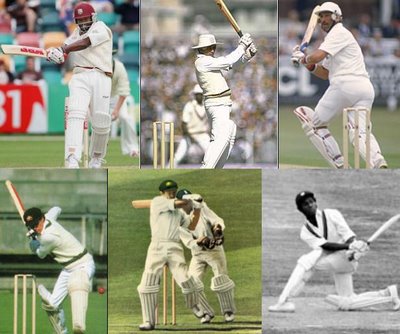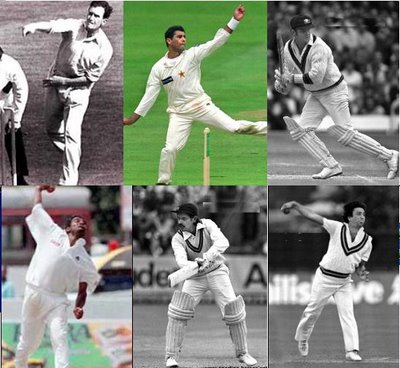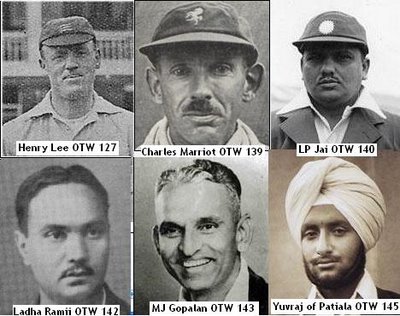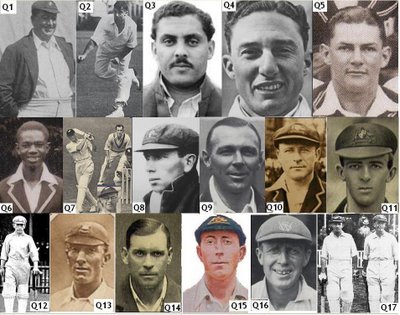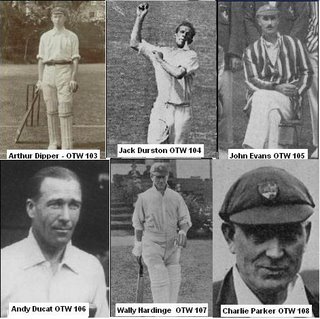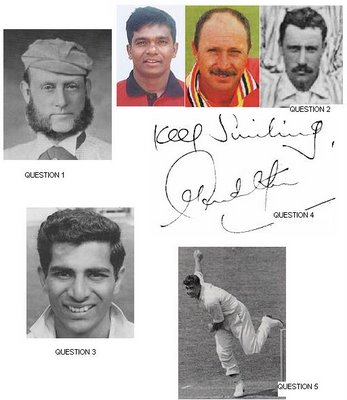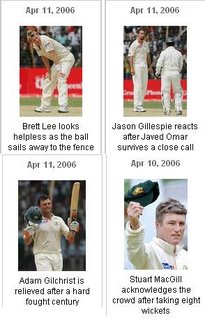The first Test match played after the War involved Australia and New Zealand and was played at Wellington from 29th -30th March 1946. New Zealand introduced six players to Test Cricket in this test which was their first ever Test match against Australia. More Australians, seven in all, which included the great Australian fast bowling pair Ray Lindwall & Keith Miller made their Test debut as well in this Test. Of these 13 debutantes, 5 Kiwis and one Australian became OTWs. New Zealand could not even score 100 runs in both their innings put together getting bowled out for 42 & 54 and lost the match by an innings 103 runs. None of the New Zealand OTWs WM Anderson (4&1), C Burke (1&3), LA Butterfield (0&0), Dan McRae (0&8), and CG Rowe (0&0) could even reach double figures in either of the innings. Australia’s KD Meuleman of Australia was out for a duck and became an OTW. C Burke took 2 wickets whereas Anderson held a catch for New Zealand. Anderson’s son RW Anderson bettered his father’s record by playing 9 Tests for NZ in between 1976 and 1878. Australia’s Meuleman held one catch. Butterfield & Rowe are two of the only 10 players of an exclusive club who registered a pair in their only Test appearance (GF Grace was the 1st and Gavin Hamilton was the last).
In the 1st Test of the 1946 England vs India Test Series, at Lord’s TF Smailes made his debut and made 25 in the only innings he batted in a Test match. He also took 3 wickets that Mankad, Modi & Lala Amarnath in India’s 2nd innings
In the 2nd Test of the 1946/47 Ashes played at Sydney, FW Freer made his entry and exit from test cricket. He remained unbeaten on 28 on the only innings that Australia batted. Freer took one wicket in the 1s innings and 2 in the 2nd. In the 4th Test of the same series played at Adelaide, Merv Harvey, brother of Neil Harvey made his only Test appearance. He made 12 & 31 and shared a hundred run opening stand with Arthur Morris, who made his second hundred of the test match.
In the One-off test between New Zealand and England played at Christchurch in 1946/47, New Zealand’s CA Snedden and RH Scott made their Solo appearance in Test Cricket. In a rain ruined Test match only two innings was possible. Scott made 18 runs and also took the wicket of Bill Edrich. Snedden did not make a single run and did not take any wicket. Neither of them took a catch.
England’s Cecil ‘Sam’ Cook and Jack Martin recorded their single test appearance when they played for England against South Africa in the 1st Test of the 1947 series. Cook 0 & 4 and did not take any wicket or any catch. Martin took 1 for 111 in South Africa’s 1st Innings and was involved in a last wicket partnership of 51 runs with Eric Hollies which in the end proved out to be a match saving partnership as South Africa could not reach the victory target of 227 runs and were 166 for 1 when the match ended. In the next test at Lord’s GH Pope replaced Cook but he too did not put up any noteworthy performance and became an OTW. Pope made 8* in the only innings he batted and took a single wicket in South Africa’s 1st innings, that of no.11 batsman VI Smith.
In the 3rd Test of the 1947 series played at Old Trafford , Jack Plimsoll of South Africa made 8 & 8* and took 3 wickets in England’s 1st innings, which remained his only Test outing.
Amir Elahi made his only Test appearance for India in the 2nd Test at Sydney during the 1947/48 series. He made 1 batting at no.10 in the 1st innings but opened the 2nd innings with Vinoo Mankad and made 13. Though this was his only appearance for India, Amir Elahi later went on to play 5 more tests for Pakistan, so he cannot be termed as an OTW in its real sense. But in the next test, the 3rd test of the series, at Melbourne Kanwar Rai Singh who made his first and last test appearance for India became the next OTW without having any strings attached. He made 2 & 24 and did not either bowl or take a catch. In the 5th Test of the same series at the same venue Len Johnson of Australia made 25*. In this innings Australia’s all eleven batsmen reached double figures and was one of ten such instances in Test Cricket. Johnson in addition to his unbeaten 25 also took 3 wickets in each of India’s two innings. His 2nd innings bowling figures read as 5.2-2-8-3. Johnson also took a catch in India’s 2nd innings to dismiss India’s captain Lala Amarnath as India was bowled out for 67.
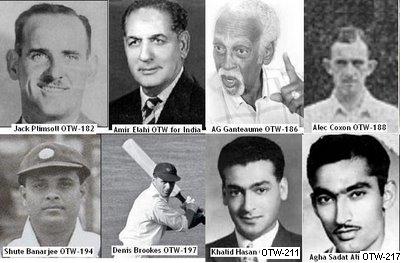
Dennis Brookes of England made 10 &7 in his only test match representation in the 1st Test of the 1947/48 Series against West Indies at Bridgetown. He also took a catch, but broke his finger while fielding and never made a test appearance again. Next OTW Andy Ganteaume of West Indies provides only instance in test cricket to have scored a century in the only test innings he ever batted. In the 2nd Test of the same series against England though Ganteaume made a century, West Indies captain Gerry Gomez was so much upset with Ganteaume’s slow batting and in fact did not even give him a chance to bat in the 2nd innings when West Indies was chasing a victory target of 141 runs and fell short by 69 runs. Ganteaume ended his career with just one test innings of 112 runs and holds the dubious distinction of being the only batsman in the history of Test cricket to have scored a Test century and have an higher average than Don Bradman.
Lance Pierre of West Indies, in the 3rd Test of the same series at Georgetown, made an insignificant entry and exit from Test Cricket. In a rain ruined Test, Pierre did not get a chance to bat in either of West Indian innings and bowled just 2 overs in the 1st and 5 overs in the 2nd without capturing a wicket.
2nd Test of the 1948 Ashes played at Lord’s has witnessed Alec Coxon of England making his solo test appearance. He made 19 & 0 and took 2 wickets in the 1st innings and one in 2nd. In the next test played at Manchester England’s George Emmett, perhaps only England Test Cricketer to have born in the land of Taj Mahal, Agra, India made 10 & 0 and failed to impress the selectors to choose him for another test match.
Keki Tarapore of India, who had more success as the manager of Indian teams that toured England in 1967 and West Indies in 1971, where India registered their first ever Test Series win against West Indies and also their 1st series victory outside India, made his test debut at Delhi against West Indies in the 1st Test of the 1948/49 series. He made just 2 runs in the only innings he batted and bowled 19 wicketless overs conceding 72 runs. In the 3rd test of the same series, played at Calcutta India’s SA ‘ Mantu’ Banerjee made his only test appearance on his home ground and took 4/124 & 1/61. He also took a catch each of West Indian innings but failed to score in the only innings he batted.
In the 3rd test of the 1948/49 series against England played at Johannesburg, South Africa’s Martin Hanley made his single test appearance. He took his only wicket in test cricket by having England’s captain FG Mann caught by Mitchell. He was run out for a duck in the only innings he came to the crease.
In the same series, Madhusudhan Rege of India became the next OTW when he made his solitary test appearance in the 4th Test at Madras. He made 15 & 0 while opening the batting for India with Mushtaq Ali. He also a took a catch to dismiss Alan Rae in West Indies’ 1st innings.
The next Indian to have earned a test debut, Shute Banerjee, incidentally, was the next OTW. Making his debut in the 5th and final test of the same series at Bombay, at an age of 35, Shute Banerjee took 1/73 & 4/54. His 2nd innings spell wrapped the West Indian innings for 267 setting up a 361 run target for India. India came within 6 runs of victory with Shut Banerjee hitting a six in the closing stages, but had to contend with a draw in the end. Banerjee made 5 & 8 in the test match and never got an opportunity to play in a test match again.
Though Shute Banerjee had put up an impressive performance in this test match, he is remembered mostly not for his single test appearance but for a last wicket partnership he put up some two years earlier with Chandu Sarwate against Surrey during India’s 1946 tour of England. They have put up a record 249 run partnership which is 2nd highest in all first class cricket. During the process Sarwate made 124* and Shute Banerjee made 121. Till today this remains the only occasion on which the no.10 and no.11 batsmen hit a century in all first class cricket. Coming into bat with Indian placed at a precarious 205/9 Shute Banerjee plundered Surrey’s bowlers which included Alec Bedser, along with Sarwate for 3hrs and 10 minutes and took India’s total to 454. India bowled out Surrey cheaply in their 1st essay for 135 and then for 338 after enforcing the follow on. India went on to win the match by 9 wickets, but its Banerjee and Sarwate whose unbelievable partnership for the last wicket which is still talked about more than the victory.
Lawrence ‘Fish’ Markham of South Africa in the 4th Test of the 1948/49 series against England at Ellis Park, Johannesburg made his only Test appearance. He made 20 runs in the only innings he came in to bat, bowled 5 wicketless overs in England’s 1st innings and took Denis Compton’s wicket in the 2nd innings in an 8 over spell conceding 34 runs.
In the 1st test of the 1949 series against New Zealand, played at Headingly, making his debut along with one of the all time great all rounders produced by England, Alan Wharton of England made just 7 & 13 and had to contend with that solo test appearance as he had to miss the next test because of injury and was never selected to play in a Test match again.
The next OTW, George Thoms of Australia too like Alan Wharton, made his debut along with one of the cricket’s all time greats Richie Benaud, in 5th and final test of the 1951/52 Series against West Indies at Sydney. He made 16 & 28 more than Benaud’s 3 & 19, but did not play in a test match again more because of his interest in medicine. He perhaps is the only Test Cricketer to have been a gynecologist by profession. He retired from cricket at the age of 27 for the fear of injuring his hand which would have jeopardized his career as doctor. He may not have regretted his decision as he became a noted surgeon and is known for introducing laser surgery to Australia.
Hiralal Gaekwad and Shah Nyalchand made their debut against Pakistan in the 2nd test of the 1952/53 series at Lucknow. Gaekwad made 14 & 8 and Nyalchand 6* & 1. Nyalchand bowled a marathon spell of 64 overs in the only innings that Pakistan batted, of which 33 were maidens. He took 3 wickets for 97 runs. Gaekwad too bowled a tidy spell of 37overs with 21 maidens, but went wicketless for 47 runs. Both Gaekwad and Nyalchand never played in tests again thus ending their careers as OTWs.
In the next test at Bombay India’s HT ‘Bal’ Dani and Rajindernath made their one test appearances. None of them could get a chance to bat as India declared their innings at 387/4 wickets. Dani, who achieved enormous success in domestic cricket as an all rounder did open the bowling for India with Lala Amarnath, but had to contend with short spells of 4 overs in the 1st innings and 6 overs in the 2nd during which he took Nazar Mohammed’s wicket for a duck. Dani also took a superb catch to dismiss to Pakistan captain AH Kardar of the bowling of Amarnath in the 1st innings. Rajindernath affected couple of stumpings in each of Pakistan’s innings.
When South Africa toured New Zealand in 1952/53, in the 1st test at Wellington New Zealand’s Eric Fisher and Ted Meuli made their only test appearance. Meuli made 15 & 23 and did not bowl or taken any catch. Fisher made 9 & 14 and took one wicket in the only innings that South Africa batted.
Roy Miller and Leslie Wight of West Indies made their test debut in the 4th test of the 1952/53 series against India at Georgetown. Miller made 23 in the only innings that West Indies batted and bowled 16 wicketless overs of which 8 were maidens. Wight made a 21 runs in a snail-paced innings with his first 12 runs taking 2 hours. Both Miller and Wight never played in Test Cricket again.
Alfred Scott of West Indies made his solitary test appearance at Kingston in the next test and made 5 runs in the only innings he batted. He did not have good match with the ball either bowling 31 wicketless overs in India’s 1st innings and another 13 in the 2nd.
In the 3rd Test of the 1953/54 series between New Zealand and South Africa, New Zealand’s Ian Leggat made his entry and exit in Test Cricket at Newlands, Cape Town by failing to either score or take a wicket. But he took couple of catches in the only innings that South Africa batted.
Michael Frederick of West Indies started his test career with a duck in the 1st innings and ended with a 30 in the 2nd innings in his lone test appearance against England in the 1st Test of the 1953/54 series at Kingston. This proved out to be not only his last test appearance but also his last first class cricket appearance which was of a very short six matches.

Next Test at Bridgetown has witnessed Charles Palmer of England, who also played in India earlier for the Europeans team in India , made 22 & 0 and did not take any wickets in 5 overs he bowled in West Indies’ 2nd innings. It needs to be mentioned that Palmer later went to record an amazing spell of bowling in first class cricket Bowling for Leiceistershire against Surrey , he brought himself on to let his main bowlers change their end,, he took 8 for 7. At one point his bowling analysis read an unbelievable : 12-12-0-8
In the 2nd test of their 1954 tour of England at Trent Bridge, three Pakistanis made their debuts. Though Mohd. Ebbu Ghazali extended his test career by playing one more test match, both Khalid Hasan and Mohammad Aslam had to end their with that solitary test appearance. Mohammad Aslam made 16 & 18 and Khalid Hasan made 10 & 7 *. Khalid Hasan also took two wickets by clean bowling both the century makers Reg Simpson for 101 & Denis Compton for 278 in the only innings that England batted. Khalid Hasan was just 16 yrs 351 days on the day he made his test debut and five days later made it as his last test, thus easily becoming the youngest OTW.
Les Watt of New Zealand joined the One-Test-Club in the first ever test match played at Dunedin, which was his home ground, during the 1954/55 series. Unfortunately he did not make any impact by getting out for 0 & 2 in his only test appearance.
Glendon Gibbs of West Indies, no relation to Lance Gibbs , has appeared in a test match for the 1st and last time when he played in the 1st test of the 1954/55 series against Australia at Kingston. He did not do much to cheer about by making just 2 runs in the 1st innings and getting bowled for a duck in the 2nd. He bowled 3 wicketless overs in the 1st and another one in the 2nd. The only catch that Gibbs took in Australia’s 2nd innings, if not remembered by him Everton Weeks may never have forgotten as Gibbs caught Arthur Morris of the bowling of Weeks giving him his only wicket in Test Cricket. In the next test at Port of Spain, Lennox Butler of West Indies joined Gibbs as the next entrant to the OTW club. He made 16 and took 2 wickets for 151 runs on a batting paradise as Australia piled up a massive total of 600. Third test of the same series played at Georgetown provided the solitary test appearance for Norman Marshall who made 0 & 8 and took a wicket in each of Australia’s innings.
Agha Sadat Ali of Pakistan, who won his test match debut primarily because of his excellent fielding against the visiting New Zealanders in a tour match, made 8* in the only innings that Pakistan batted in the rain ruined 3rd and final test match of the 1955/56 Series played at Dhaka, then part of East Pakistan. However, he did not disappoint the selectors’ faith in his fielding by holding 3 catches in the field.

 Dennis Brookes of England made 10 &7 in his only test match representation in the 1st Test of the 1947/48 Series against West Indies at Bridgetown. He also took a catch, but broke his finger while fielding and never made a test appearance again. Next OTW Andy Ganteaume of West Indies provides only instance in test cricket to have scored a century in the only test innings he ever batted. In the 2nd Test of the same series against England though Ganteaume made a century, West Indies captain Gerry Gomez was so much upset with Ganteaume’s slow batting and in fact did not even give him a chance to bat in the 2nd innings when West Indies was chasing a victory target of 141 runs and fell short by 69 runs. Ganteaume ended his career with just one test innings of 112 runs and holds the dubious distinction of being the only batsman in the history of Test cricket to have scored a Test century and have an higher average than Don Bradman.
Dennis Brookes of England made 10 &7 in his only test match representation in the 1st Test of the 1947/48 Series against West Indies at Bridgetown. He also took a catch, but broke his finger while fielding and never made a test appearance again. Next OTW Andy Ganteaume of West Indies provides only instance in test cricket to have scored a century in the only test innings he ever batted. In the 2nd Test of the same series against England though Ganteaume made a century, West Indies captain Gerry Gomez was so much upset with Ganteaume’s slow batting and in fact did not even give him a chance to bat in the 2nd innings when West Indies was chasing a victory target of 141 runs and fell short by 69 runs. Ganteaume ended his career with just one test innings of 112 runs and holds the dubious distinction of being the only batsman in the history of Test cricket to have scored a Test century and have an higher average than Don Bradman.









